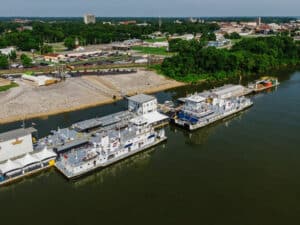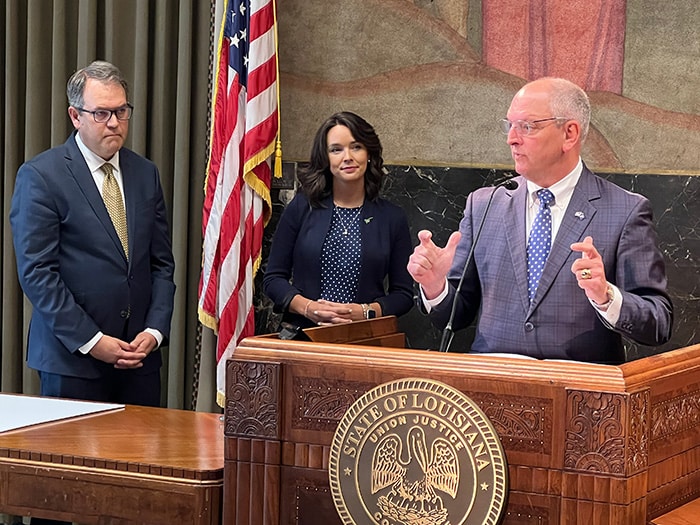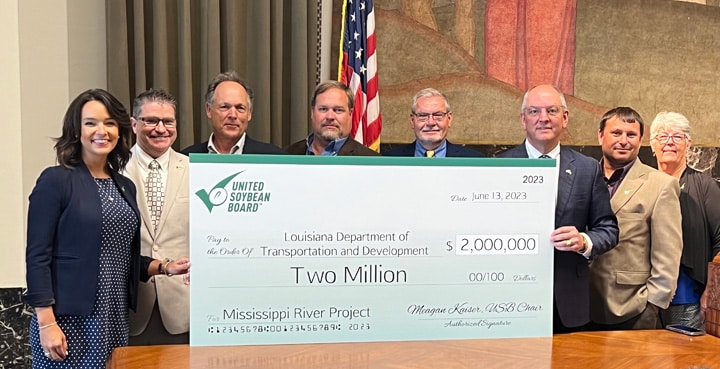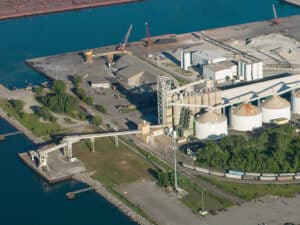
Lower Mississippi River deepening gets a $2 million ceremonial boost
Written by Nick Blenkey
Louisiana Gov. John Bel Edwards: “Sixty percent of the nation’s grains are exported down the river. We believe we can get to 70%, but to do that, we’ve got to go from 45 feet to 50 feet up here to Baton Rouge.” [ United Soybean Board photo shows, L to R, Mike Steenhoek (Executive Director – Soy Transportation Coalition), Meagan Kaiser (Chairwoman – United Soybean Board), Gov. Edwards.]
Soybean farmers had a belated date with Louisiana Gov. John Bel Edwards at the State Capitol in Baton Rouge, La., this past Tuesday. They presented him with a $2 million ceremonial check for the lower Mississippi River deepening project. Hopes had been to make the presentation to coincide with the beginning of the deepening project, but the COVID pandemic put those plans on a lengthy hold.
Back in July 2019, the United Soybean Board (USB) announced a $2 million allocation to help offset the planning, design, and research costs of deepening the lower Mississippi River from 45 feet to 50 feet. The overall project will cost approximately $245 million. It is being 75% funded by the federal government, and 25% by non-federal sources. The State of Louisiana is the designated entity responsible for the 25% non-federal cost sharee and the $2 million provided by the United Soybean Board is helping offset some of the project costs assumed by the Louisiana Department of Transportation and Development.

The 256-mile stretch of the Mississippi River from Baton Rouge to the Gulf of Mexico routinely accounts for 60% of U.S. soybean exports, along with 59% of corn exports – by far the leading export region for both commodities. Soybean farmers and a large number of Mississippi River stakeholders have promoted the dredging of the lower river shipping channel to 50 feet in depth.
In February of 2020, the U.S. Army Corps of Engineers provided approval for the deepening project to proceed. The signing ceremony officially kicking off the project occurred on July 31, 2020, with the dredging work starting on September 11, 2020.
Currently a 50-foot or deeper navigation channel has been achieved up to Mile 175. The remaining deepening work up to Mile 232 should be completed by early 2025.
Research conducted by the Soy Transportation Coalition (STC) indicates that shipping costs for soybeans from Mississippi Gulf export terminals would decline 13 cents per bushel ($5 per metric ton) once the lower Mississippi River is dredged to 50 feet. A deeper river will allow both larger ships to be utilized and current ships being utilized to be loaded with more revenue-producing freight. Average vessel loads will increase from 2.4 million bushels of soybeans (66,000 metric tons) to 2.9 million bushels (78,000 metric tons) – an increase of 500,000 bushels or a 21% increase.
The research also identifies the impact on an interior basis – the difference between the local price a farmer receives and the market value established by the Chicago Board of Trade – for soybeans in 31 states if the lower Mississippi River shipping channel is dredged. It is well established that farmers located in closer proximity to the nation’s inland waterways and barge transportation enjoy a positive or less negative basis vs. soybeans grown in areas further removed. As a rule, the less-costly and more efficient the supply chain is subsequent to farmers delivering their soybeans, the higher value a farmer will receive for the bushels of soybeans produced.
The STC research estimates farmers in the 31 evaluated states will annually receive an additional $461 million for their soybeans due to dredging the lower Mississippi River to 50 feet. While those states located in close proximity to the inland waterway system will realize the most benefit, states further removed will also benefit from the increased modal competition between rail and barge. When modal competition increases, a downward pressure on shipping rates will often occur. With barge transportation becoming more viable for a larger percentage of the soybean-producing areas of the country, there will be a greater degree of overlap between areas served by railroads and barge. Soybean shippers will benefit from this modal competition.

![Tom Frazier aground and listing to starboard on Feb. 11, 2024. [Photo: U.S. Coast Guard]](https://www.marinelog.com/wp-content/uploads/2025/06/Towboataground-300x225.jpg)


